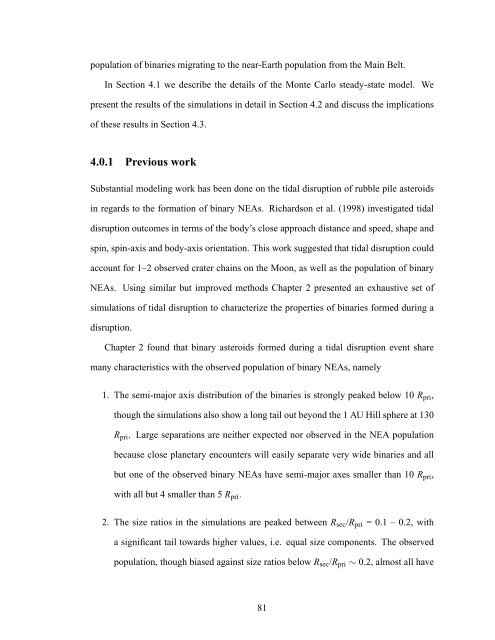Forming Binary Near-Earth Asteroids From Tidal Disruptions
Forming Binary Near-Earth Asteroids From Tidal Disruptions
Forming Binary Near-Earth Asteroids From Tidal Disruptions
You also want an ePaper? Increase the reach of your titles
YUMPU automatically turns print PDFs into web optimized ePapers that Google loves.
population of binaries migrating to the near-<strong>Earth</strong> population from the Main Belt.In Section 4.1 we describe the details of the Monte Carlo steady-state model. Wepresent the results of the simulations in detail in Section 4.2 and discuss the implicationsof these results in Section 4.3.4.0.1 Previous workSubstantial modeling work has been done on the tidal disruption of rubble pile asteroidsin regards to the formation of binary NEAs. Richardson et al. (1998) investigated tidaldisruption outcomes in terms of the body’s close approach distance and speed, shape andspin, spin-axis and body-axis orientation. This work suggested that tidal disruption couldaccount for 1–2 observed crater chains on the Moon, as well as the population of binaryNEAs. Using similar but improved methods Chapter 2 presented an exhaustive set ofsimulations of tidal disruption to characterize the properties of binaries formed during adisruption.Chapter 2 found that binary asteroids formed during a tidal disruption event sharemany characteristics with the observed population of binary NEAs, namely1. The semi-major axis distribution of the binaries is strongly peaked below 10 R pri ,though the simulations also show a long tail out beyond the 1 AU Hill sphere at 130R pri . Large separations are neither expected nor observed in the NEA populationbecause close planetary encounters will easily separate very wide binaries and allbut one of the observed binary NEAs have semi-major axes smaller than 10 R pri ,with all but 4 smaller than 5 R pri .2. The size ratios in the simulations are peaked between R sec /R pri = 0.1 – 0.2, witha significant tail towards higher values, i.e. equal size components. The observedpopulation, though biased against size ratios below R sec /R pri ∼ 0.2, almost all have81












